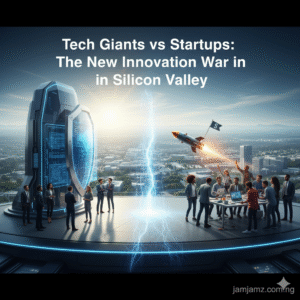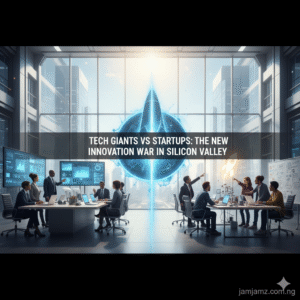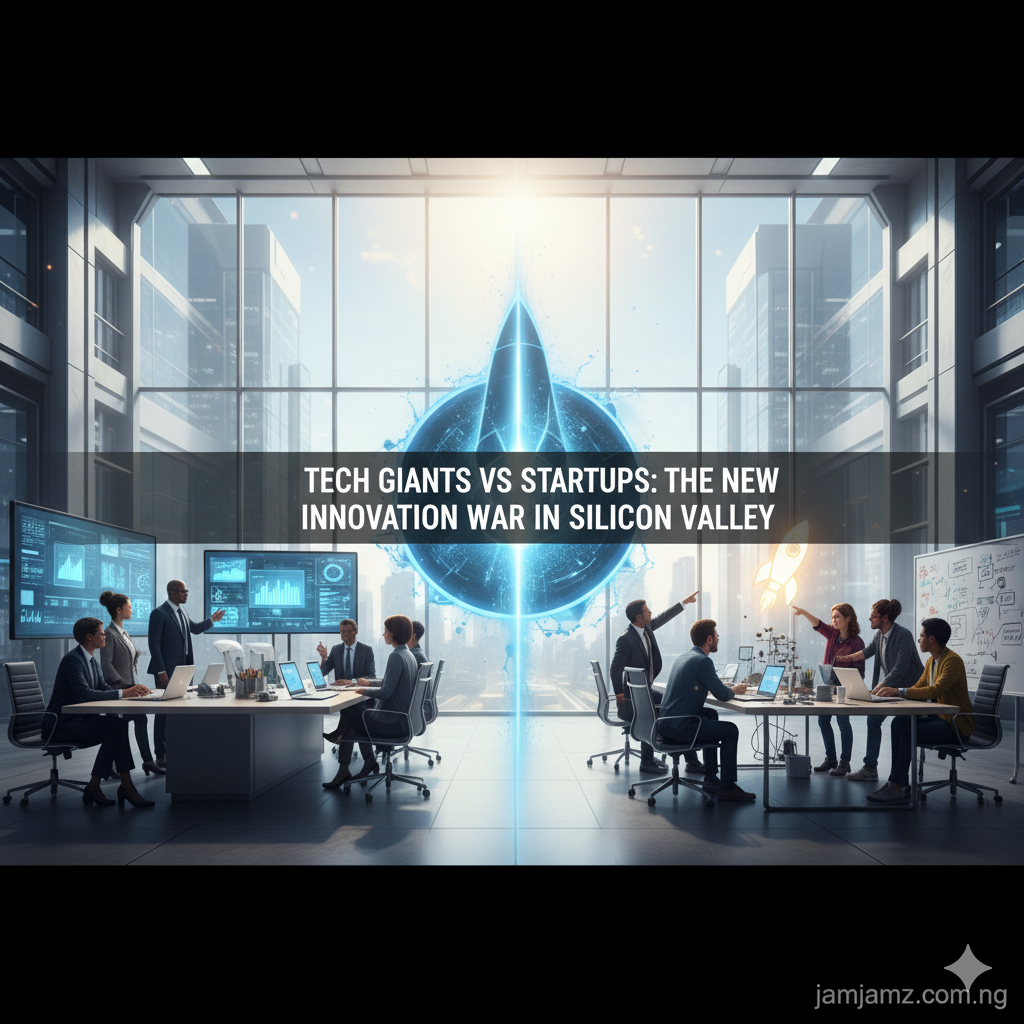Tech Giants vs. Startups: The New Innovation War in Silicon Valley
In the world’s technology capital, Silicon Valley, a major clash unfolds daily. This isn’t a simple rivalry it’s a full scale innovation war between tech giants vs. startups. Global leaders like Apple, Google, and Microsoft face off against bold, fast-moving startups eager to disrupt established norms.
Both sides chase the same prize: dominance in the digital economy. While large corporations rely on massive resources and infrastructure, startups rely on creativity, agility, and fearless innovation. The struggle between these two forces defines how new ideas become global revolutions.

The Power and Reach of the Tech Giants
Tech giants dominate markets through their scale, reach, and data. Over decades, they’ve built powerful ecosystems connecting billions of people and businesses. They control everything from cloud computing and software development to social media and artificial intelligence.
Their strength lies in integration. They connect products, devices, and services into seamless networks that users can’t easily leave. Their vast budgets allow them to fund deep research, attract top talent, and acquire rising companies before they become major threats.
However, their massive size also slows them down. Decision-making becomes complex. Risk-taking fades. Innovation often gives way to caution and that’s where startups thrive.
ALSO READ: How to Choose the Best Life Insurance Policy for Your Family
The Startup Spirit of Silicon Valley
Startups embody speed, creativity, and the courage to challenge the impossible. They begin small, but their ambition runs high. Founders often launch with a single bold idea an idea that could solve a big problem or transform a stagnant industry.
Startups flourish because they move fast. Without the weight of bureaucracy, they can test, fail, and improve quickly. Every experiment brings new insights, and each breakthrough drives the next leap forward.
In Silicon Valley, this mindset creates waves of transformation. Startups build the tools and services that tech giants later acquire or imitate. They breathe new life into industries that once seemed untouchable.
Tech Giants Adapt to the Startup Threat
Tech giants have learned to counter startup disruption in clever ways. They’ve shifted from ignoring small competitors to actively monitoring, partnering with, or acquiring them.
1. Acquisition
Large corporations buy promising startups before they grow into serious rivals. These deals give giants access to innovation and fresh talent while removing potential competition.
2. Replication
When startups create something unique, tech giants often build their own versions. Their scale lets them roll out similar features worldwide in weeks, reaching users faster than startups can.
3. Collaboration
Many big firms now collaborate with startups through incubators, funding programs, or innovation labs. This approach helps giants stay connected to emerging ideas while startups gain mentorship and exposure.
Through these strategies, tech giants maintain dominance — but they also acknowledge that innovation can’t survive without the energy and daring spirit of startups.
Why Startups Still Win the Innovation Game
Startups hold one major advantage: freedom. They don’t answer to thousands of shareholders or layers of management. Their teams make bold decisions without hesitation.
They also prioritize purpose over profit in the early stages. Startups chase ideas that matter ideas that solve human problems or reshape how society interacts with technology. This purpose-driven culture attracts creative minds who want to make a difference, not just collect a paycheck.
In this sense, startups operate like laboratories for the future. They take risks, explore unconventional paths, and push the boundaries that corporations often fear to cross.
Venture Capital: Fuel for the War
Behind every successful startup lies a network of investors who believe in its vision. Venture capital provides the financial firepower to grow rapidly, test products, and capture markets before rivals react.
Venture firms compete just as fiercely as the startups they fund. They seek disruptive ideas in sectors like AI, clean energy, fintech, and biotech. The race for the next billion-dollar company never stops.
Even major corporations now play in this space. Google, Intel, and Amazon all run venture arms that invest in startups, hoping to spot the next breakthrough early. This mix of competition and cooperation keeps the innovation ecosystem alive.
Culture: The Real Battlefield
The biggest difference between tech giants vs. startups isn’t money or manpower it’s culture.
Startups operate on passion and risk. Every member of a small team feels ownership over success or failure. The environment encourages creative thinking, collaboration, and continuous learning.
Tech giants, on the other hand, thrive on structure. They focus on scalability, consistency, and system efficiency. Their culture values precision and long-term vision, but often limits flexibility.
The result? Startups spark the ideas, and corporations perfect them for mass adoption. Together, they form a cycle that drives technological progress.
Artificial Intelligence and the New Frontier
Artificial intelligence (AI) stands at the center of today’s innovation war. Startups design new models, applications, and data systems at incredible speed. Meanwhile, big tech companies integrate AI into their vast platforms, from cloud tools to smart devices.
Startups innovate with creativity and speed. Giants scale innovation across billions of users. Both push AI forward, creating a feedback loop of progress. This collaboration-competition dynamic has made AI the defining technology of our generation.
The Battle for Talent
The fight for skilled workers mirrors the competition for innovation. Engineers, researchers, and developers choose between two very different worlds: the stability of corporate tech and the excitement of startup life.
Startups attract those who value creativity, ownership, and impact. Giants attract experts who seek resources, mentorship, and long-term growth. Many professionals move between both environments during their careers, blending experience from each side and keeping innovation fluid across the entire industry.
This constant flow of talent fuels both startup success and corporate reinvention.
Policy, Regulation, and Power Shifts
As technology influences everything from finance to healthcare, governments have begun tightening regulations. Data privacy, AI ethics, and antitrust policies now shape how both startups and tech giants operate.
For startups, new rules can limit flexibility but also create opportunity. Regulations often force big corporations to adapt slowly, leaving room for smaller innovators to move ahead.
For large companies, compliance becomes a challenge that demands resources and focus. The push for transparency and accountability redefines how they manage innovation and competition.
The result is a more balanced ecosystem, where agility and integrity both play crucial roles.

The Next Phase of Silicon Valley Innovation
The innovation war continues to evolve. As technology expands into new industries, fresh battles emerge.
1. Sustainability
Startups lead the charge in renewable energy, waste reduction, and green manufacturing. Giants follow with large-scale environmental commitments and global initiatives.
2. Web3 and Decentralization
Startups explore blockchain and decentralized systems that challenge corporate control over data and platforms. Tech giants experiment cautiously, integrating these systems into existing infrastructures.
3. Health and Biotech
Health tech startups create apps and devices that personalize care. Major corporations invest heavily in digital health to stay relevant in this rapidly changing space.
4. Robotics and Space Exploration
Startups innovate with automation and low-cost satellite technology. Giants pour billions into space missions, robotics, and autonomous systems. The two sides often collaborate, combining bold ideas with vast resources.
Who Leads the Future?
There’s no clear winner in this battle. The strength of Silicon Valley lies in the balance between agility and scale. Startups imagine new worlds. Tech giants make them real.
When startups push boundaries, giants react and together they advance technology faster than either could alone. Every product, app, and platform reflects this constant tug-of-war between speed and scale.
The result benefits everyone: consumers enjoy better tools, smarter systems, and faster innovation.
Conclusion: The Endless Cycle of Innovation
The rivalry between tech giants vs. startups defines the heartbeat of Silicon Valley. It’s not just competition it’s collaboration in disguise. Startups spark change. Giants amplify it.
This cycle never ends because innovation never stops. As long as bold thinkers dream and massive corporations execute, technology will keep evolving. The future of Silicon Valley, and indeed global innovation, depends on the energy of both sides the daring of startups and the might of giants.
Together, they shape the digital future we live in today.
